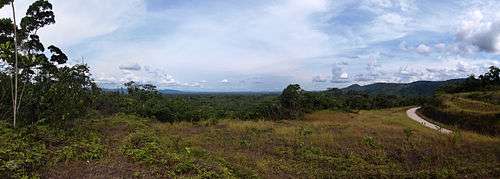Maiko National Park
Maiko National Park is in Congo Basin region of Democratic Republic of Congo (DRC).
Understand
This massive 10,400 km² park is about half way between Bukavu at the Rwandan border, and Kisangani. The park has not been developed for visitors—there are no airstrips, no lodges, and no amenities to speak of. There is just one 4x4 track leading from Bafwasende to some small villages within the park. The park is located in an undeveloped section of the DRC and is home to many primitive tribes along with rebels, who have made there home in the park at the end of past conflicts. The people within the park practice subsistence hunting, which doesn't bode well for the park's wildlife, which is facing significant pressure. The park is managed by the Institut Congolais pour la Conservation de la Nature (ICCN) which, despite the absence of rangers and facilities, is responsible for entry permits. ICCN has control over the park in law, but villages of rebels and native tribes retain control over the park.
History
The park has its origins in the Bakumu Hunting Reserve established by the Belgian colonial administration in order to protect the land and its wildlife from being affected by mineral exploitation. Following their defeat in 1964, many Simba rebels found this road-less & inaccessible region to be the perfect location to settle. In 1970, President Mobutu established the park. More rebel groups made their home in the remote corners of the park in the late 1990s and around 2007. The first survey of the park was done in 1989, while more thorough surveys were conducted around 2005-6 & 2010. While the park is remote and inaccessible by all accounts, attempts to provide humanitarian aid (like schools & health centers) have only begun around 2010 and in the coming years efforts to provide access to the park and basic facilities will—hopefully—come to fruition.
Landscape
Dense equatorial forest and two major rivers - the Oso and the Lindi.
Flora and fauna
Three of the country's spectacular endemic animals occur here: the Eastern Lowland Gorilla, the Okapi, and the Congo Peacock. Also Forest Elephants and Leopards. The park is home to numerous endemic & rare species and, almost certainly, many rare species yet to be documented. However, the presence of former rebels who have made their homes in the park, along with illegal mining and poaching means that many species are threatened with extinction. One example, a new gorilla subspecies first documented in a 2005 survey was not found and believed extinct in a 2010 survey.
Climate
Get in
Fees and permits
A permit is required from the ICCN for approximately US$100. Their nearest office is in Kisangani (+243 099 770 02895). ICCN headquarters are at Virunga National Park.
Get around
There is just one 4x4 "road" leading from Bafwasende to some small villages within the park. There are some off-piste 4x4 tracks for only the most die-hard overlanders in properly-equipped vehicles can tackle.
See

Do
Buy
Eat
Drink
Sleep
There are no lodging facilities within the park. Visitors should plan to bring their own camping supplies and may be able to spend the night in one of the scattered villages.
Stay safe
Go next